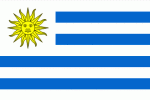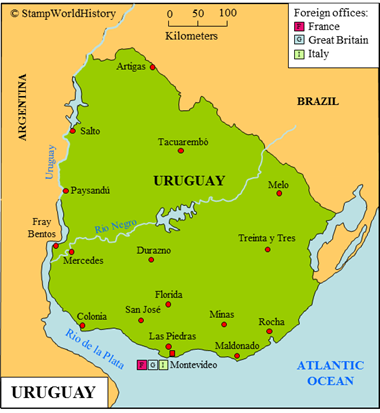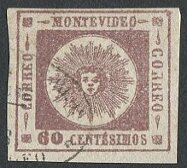
Uruguay
Quick reference
General issues: Carrier issues 1856-1858, Republic 1859-Present
Country name on general issues: ‘Diligencia’, Montevideo, Republica Oriental, (Republica (Oriental) del) Uruguay
Currency: 1 Peso = 8 Reales, 1 Real = 100 Centavos 1856-1864, 1 Peso = 100 Centesimos = 1000 Milesimos 1864-1975, 1 Peso = 100 Centesimos 1975-Present
Population: 943 000 in 1900, 3 400 000 in 2013
Political history Uruguay
Uruguay is located in South America. Before colonization Uruguay was populated by Amerindian peoples of which the Charruá were the most important. Both the Portuguese – in 1514 – and the Spanish – in 1516 – claim to have been the first to explore the future Uruguay. Uruguay was not colonized until the 17th century when both the Spanish – in 1624 – and the Portuguese – in 1669 – established the first permanent settlements. Uruguay would be disputed between Portugal and Spain until 1777 when Spain, by treaty, gained possession of Uruguay. The Spanish would administer Uruguay as the province of Montivideo, a part of the Viceroyalty of Rio de la Plata, to which also the current Argentina, Bolivia and Paraguay belonged.
After Napoleon had conquered Spain, independence movements swept across the Spanish possessions in the Americas. The struggle for independence in Uruguay would last from 1811 to 1828. A struggle in which Uruguay not only faced the royalists loyal to Spain, but also interventions by Argentina and Brazil, both intent on annexing Uruguay. Independence was eventually gained under British pressure. The British preferred a neutral buffer state on the banks of the commercially and strategically important Rio de la Plata. The 1830 constitution established the newly independent Uruguay as the ‘Republica Oriental del Uruguay'[1]Literally this translates to the ‘Republic East of the Uruguay’ – the most common translation though is the ‘Oriental Republic of Uruguay’. .
Independence would not bring Uruguay political stability. Conflicting interests of the oligarchies in trade oriented Montevideo – united as the ‘Colorados’ – and in the agrarian inland – united as the ‘Blancos’ – would escalate into civil war several times. The most devastating conflict would be the civil war fought between 1843 and 1852 – called the ‘Guerra Grande'[2]‘Great War’ in Uruguayan history. From 1864 until 1870, Uruguay was furthermore engaged in the Triple Alliance War – the largest military conflict in the history of South America in which an Alliance of Argentina, Brazil and Uruguay faced Paraguay. Although the war ended in victory for the Alliance, Uruguay suffered considerable losses.

Uruguay is traditionally an agrarian country. Raising livestock has a long tradition. Currently beef accounts for 10% of the export.
In 1876, the military seized power and – albeit at the cost of dictatorial rule – stabilized the country. Uruguay had an economic upswing, increasing its exports of livestock. Immigration from Europe grew to large numbers, rapidly increasing the population. In 1890, Uruguay reverted to civilian rule, and in the first decade of the 20th century would be transformed into a modern democratic state. Social reforms were introduced that made Uruguay one of the most progressive countries in the world. The economic crisis following the crash of 1929 again brought a dictator to power, but democracy was restored in 1938. Following a diminishing demand for livestock, the Uruguay economy had a downturn in the late 1950’s. Social unrest culminated in the armed opposition to the government by the urban guerrilla movement of the Tupamoros. In 1970, the military once again seized power. The military managed to subdue the Tupamaros and democracy was restored in 1985. Since then, Uruguay has been ruled by democratically elected presidents. Uruguay is currently considered to be one of most developed democracies in South America.
Economically, Uruguay has traditionally been, and still is, an agricultural country, agricultural products accounting for a large part of the exports. The largest sector in the economy is the services sector though, accounting for 70% of the GDP. On the United Nations Human Development Index, Uruguay is qualified as a high development country and ranks third of the South American countries, just after Argentina and Chile. The population is 90% white and 8% mestizo – people of mixed white and Amerindian origin. The indigenous Amerindians are all but extinct.
Postal history Uruguay
The first stamps were issued in Uruguay in 1856. The government granted a concession to Atanasio Lapido, the administrator-general of posts, to issue stamps. These first stamps were issued for inland use by stage coach companies providing postal services. They were inscribed ‘Diligencia'[3]‘Stage coach’ . The stamps are of a simple but striking design: a radiant ‘Sol de Mayo'[4]‘May Sun’ . The Sol de Mayo is the national emblem of Uruguay and Argentina. Mayo refers to the May Revolution in 1810, the start of the fight for independence from Spain by the countries in the Viceroyalty of Rio de la Plata. Subsequent to the diligencia issues, stamps were issued in 1858 for the services by ferry across the Rio de la Plata to Argentina – now inscribed ‘Montevideo’. All these issues are in the high to very high catalog value ranges.
Nationwide use of stamps was introduced by decree in 1859. The first government stamps were issued in 1859 – stamps also showing the Sol de Mayo and inscribed ‘Montevideo’ – and are much more affordable than the previous issues. In 1864, stamps of a new design were introduced – showing the coat of arms and inscribed ‘Republica Oriental’. Later stamps will be inscribed Republica Oriental del Uruguay, Republica del Uruguay and simply Uruguay. Uruguay has largely issued stamps with themes of national interest.
British, French and Italian offices operated in Montevideo. These offices handled most of the international mail until Uruguay joined the UPU in 1880. In the British and French offices the general issues of these countries were used. In the Italian office, the issues for Italian offices abroad were used – general issues overprinted ‘Estero’.
Album pages
← Previous page: United StatesNext page: Venezuela →





